water
Bigger Better Bottle Bill
 Yesterday the New York State Assembly passed legislation to update the State’s “Bottle Bill”... with the “Bigger Better Bottle Bill.”
Yesterday the New York State Assembly passed legislation to update the State’s “Bottle Bill”... with the “Bigger Better Bottle Bill.”
The bill (A-8044-A/Sweeney) expands the five-cent bottle deposit and refund to include non-carbonated beverages such as bottled water, iced teas and sports drinks. Unredeemed deposits will help fund New York’s Environmental Protection Fund. The old bottle bill did not require deposits on non-carbonated beverage containers, nor did it mandate that revenues from unclaimed deposits be paid to the State. Bottled water, teas, juices and sports drinks didn’t much exist when the initial law was passed in 1982, but have since grown to 25% of the market.
From the bill’s accompanying memo:
“New York’s ‘bottle bill’ is one of the State’s most successful recycling and anti-litter initiatives. There is less litter and broken glass in our streets, farm fields, playgrounds, parks and beaches as a result of the bottle bill. It has also reduced the burden of solid waste disposal that is shouldered by local governments and taxpayers.
Since the enactment of the original bottle bill in 1982, non-carbonated beverages such as bottled water, juices, teas and sports drinks have become extremely popular. Millions of bottles and cans from such beverages end up in the trash or littering the environment because consumers lack an incentive to recycle such containers.
Updating the bottle bill to include non-carbonated beverages will provide an incentive to make our environment cleaner and safer by increasing recycling. By requiring beverage companies to provide unclaimed deposits to the State for deposit into the EPF, the bill will also generate new funding for State and local environmental programs. It is estimated that expansion of the bottle bill will result in at least $100 million for deposit into the EPF.”
Watch a two minute video overview on YouTube from the Surfrider Foundation.
The bill was passed unanimously in the Assembly, but faces opposition in the State Senate. The law is opposed by big beverage corporations, grocers and liquor store owners who anticipate higher operating costs. On the other hand, the bill has an impressive list of supporters. NYPIRG has a campaign page up at http://www.nypirg.org/enviro/bottlebill.
Bottlebill.org tracks container deposit laws around the world that require a minimum refundable deposits on beverage containers.
Water Table
Articles on the New York Times website do not generally retain graphics and photos used in the print edition, particularly among older articles. So for a presentation on information design for advocacy, I went offline and dug up that graphic mentioned here. You know, the one that persuaded Bill Gates to shift his philanthropic strategy from cheap computers to public health? The graphic that “saved more lives in Africa and Asia than any other in history”?
Here’s the text of the 1997 article associated with the graphic, For Third World, Water Is Still a Deadly Drink.
And a view of the graphic within the context of the page:

And finally, the graphic itself:
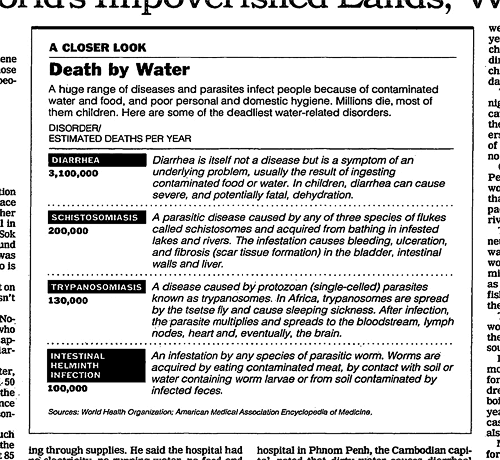
After such an awe-inspiring setup, it’s remarkable to me just how unremarkable the graphic actually is. Particularly compared to many of the examples I used in my little pamphlet on information design, there’s nothing really visually compelling or innovative about this one. But perhaps that’s part of its impact: just a clear, concise table calling out key data. The graphic gets out of the way of the information. And while the numbers themselves are stark, I think its power also comes from its context within the brutality described in the narrative — and that for the most part, clean water and sanitation are not problems we don’t know how to solve.
Puppet Regime, 2

The water puppet form was invented around 1,000 years ago in the rice paddies of north Viet Nam. Once a tradition in the flooded fields, the form is now firmly folkloric, performed in the captial on a contemporary stage flooded with water. Wooden puppets are held up on bamboo poles hidden under the water and controlled from behind a curtain at the back of the stage. Our show in Hanoi consists of 12 short vignettes along with a musical prelude.
Many of the stories take place in and around the water: fantastic tales of magical fish, swimming and spitting dragons and other animal deities, moments of legendary history, and — most interesting to me — scenes mundane, every day life. Why would people living and working in the fields need to tell a story consisting of people living and working in the fields? Is it a celebration? A means of education or identification? That this is who we are, and these are our stories? Planting rice and catching fish takes place in the same narrative space, on the same stage as the emperor who returns his sword to the giant turtle in the lake, within the same frame as the dancing dragons, mating phoenix birds and other gods of nature who tease us and manipulate the world.
After the climactic, splashing dance of the four holy animals is the curtain call. The curtain rises, the players and bamboo mechanisms are revealed — it is the puppeteers who manipulate the gods.
Geometry, 2
Reader sum1 writes in response this post touting the Q-Drum. He notes a similar product also launched in South Africa called the Hippo Water Roller. While a 1997 Time article reports the Q-Drum’s launch in 1994, the Hippo Roller Web site cites a South African Bureau of Standards 1992 Design Award.
Both are rugged, round water containers designed to be rolled on tough rural roads. But while the Q-Drum is shaped like a tubular donut with a hollow inner core, the Hipporoller is notched at both ends for the attachment of a clip-on steel tube one can use to to pull or push.
Pushing the container in front of the user has the additional advantage of acting as a buffer against landmines.
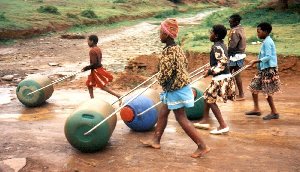
Geometry
Q-Drum Rollable Water Bottle
“Water in adequate quantities is too heavy to carry. The burden of fetching water, invariably over long distances by cumbersome and far too often, unhygienic means, is all too evident in rural Africa.... The Q-Drum is a low cost rollable water container for developing countries. The idea of the Q-Drum originated in response to the needs of rural people for clean and potable water, as well as easing the burden of conveying it....
The Q-drum is user friendly and the unique longitudinal shaft permits the drum to be pulled using a rope run through the hole. There are no removable or breakable handles or axles, and the rope can be repaired on the spot or replaced by means available everywhere, such as a leather thong or a rope woven from plant material.”
More: http://www.qdrum.co.za
Watercone
The Watercone is a transparent, polycarbonite cone tuns salt water into potable water cheaply using the power of the sun. The system can produce one liter of clean drinking water a day. Salt water poured into the base evaporates and condenses onto the wall of the cone, trickling into a circular trough at the inner base of the cone. Then just unscrew the cap and turn the cone upside down to pour the potable water into a drinking device.
The cone is non-toxic, non-flammable and 100% recyclable. The black pan for the saltwater is made out of 100% recycled plastic.
More: http://www.watercone.com
Safe Bottle Lamp
“In his hospital alone they were seeing someone die from lamp burns three times a week and thousands of people horribly disfigured, their lives ruined by a preventable accident....
Lamp-burns, [Wijaya Godakumbura, a surgeon in Sri Lanka,] realized, are a disease of poverty. Only the very poor use makeshift lamps. And because they are very poor, no-one is much concerned to do anything to help them. Most of the victims are female and nearly a third are children. Yet, it seemed to him, the problem was preventable....
‘I decided the best design was based on a simple Marmite bottle – small and squat, with two flat sides – equipped with a safe screw-cap to hold the wick. That way, the bottle was more stable. The fuel does not spill if the bottle overturns. It cannot roll. It is strong enough not to break if dropped.’”
In these pages I’m usually down on depoliticized, product-based fixes for poverty. But then sometimes the impact of a simple change in form is astonishing.
Permeable Pavement
Permeable pavement allows rainwater to filter into the ground while providing a durable surface for vehicles to drive on. While gravel driveways and other pourous materials are a common form of this, other types composed of interlocking concrete blocks or plastic cell networks can allow vegetation to poke through.
Permeable systems can cost more to lay than asphalt or poured concrete and, depending on the material, may require more maintenance. But the results are more aesthetically pleasing, more environmentally responsible, and may save money in the long run.
By allowing rainwater to soak into the ground, permeable systems slow run-off and flooding the sewer systems. Allowing grass and plants to grow improves air quality and reduces the heat island effect.
Permeable paving works best in low traffic areas, like alleys, parking lots, or bus stops, and in some cases may have the additional bonus of calming traffic.
So why wait for an old railroad to be decommissioned before turning it into a greenway? Via Beyond Brilliance, Beyond Stupidity I found this post about permeable paving along the new tram line in Barcelona. The photos show what a lovely difference it makes.
The organization City Farmer worked with the government of Vancouver on three trial installations in their County Lanes project. Read more about the budget and process at the City of Vancouver Web site:
“After evaluating the three designs for their durability and performance, a standard Country Lanes design will be developed. Vancouver is also planning to develop a ‘Sustainable Street’ that incorporates many of the features of the Country Lanes.”
Gaviotas
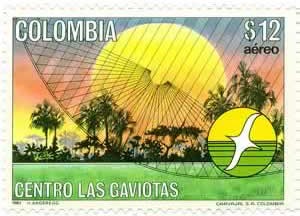
In 1965 Paulo Lugari was flying over the impoverished Llanos Orientales, the “eastern plains” that border Venezuela. The soil of the Llanos is tough and acidic, some of the worst in Colombia. Lugari mused that if people could live here they could live anywhere.
The following year Lugari and a group of scientists, artists, agronomists and engineers took the 15-hour journey along a tortuous route from Bogota to the Llanos Orientales to settle. The local population, including the indigenous Guahibo people, familiar with the political terror and violence of the ‘white man,’ were naturally suspicious.
Nearly 40 years later, while war rages across Colombia with the help of U.S. funds, equipment, and training, the 200 residents of Gaviotas, including farmers, scientists, artists, and former street kids, have created a thriving village and environmental research center in Vichada in Los Llanos.
“Gaviotas is named after a bird that enlivens the rivers at dusk.” [source]
“They have planted millions of trees, thus regenerating an indigenous rainforest. They farm organically and use wind and solar power. Every family enjoys free housing, community meals, and schooling. There are no weapons, no police, no jail. There is no mayor.” [source]
“Gaviotas provided a chance to plan a tropical civilization from the ground up, instead of depending on technologies developed for northern climates. ‘When we import solutions from the US or Europe,’ said Lugari, founder of Gaviotas, ‘we also import their problems.’
Over the years Gaviotas technicians have installed thousands of the windmills across Colombia - in some places gaviotas is the local word for windmill.”
Around 58 types of windmill were tried and tested before the pioneers came up with determined that the distinctive ‘sunflower’ design functioned best in the plains.
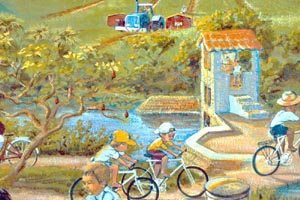 “Since Gaviotas refuses to patent inventions, preferring to share them freely, the design has been copied from Central America to Chile.
“Since Gaviotas refuses to patent inventions, preferring to share them freely, the design has been copied from Central America to Chile.
Electricity comes from a low-head turbine powered by a stream, except in the short dry season, when it is backed up by a diesel generator. ‘In 24 years we’ve learned to cover 70 percent of our food and energy needs,’ says Gonalo Bernal, administrator of Gaviotas. ‘The trees we plant more than compensate for any greenhouse gases we emit. Imagine if the rest of the world lived like us.’
Gaviotas began as a collection of researchers, students, and laborers sharing vehicles, bedding, dishes, clothes - and decisions. In time several of their families joined them and a permanent colony with individual houses emerged. Government was by consensus and unwritten rules. To limit public disorder, alcohol is confined to homes. To preserve wildlife, dogs and guns are banished. A need for police, jail, or door locks has never arisen. Anyone who violates protocol, like a storekeeper who recently admitted to overcharging, is ostracized by the community until his debt is paid. Loafers aren’t tolerated, but with wages above the Colombian minimum wage, plus free meals, medical care, schools, and housing, loafing isn’t a problem.
A techno-tour of the llanos shows how Gaviotas has revolutionized life here. The most significant invention is a simple hand pump capable of tapping aquifers six times deeper than conventional models, but requiring so little effort that children can operate it. In normal pumps a heavy piston must be raised and lowered inside a pipe. Gaviotas engineers realized they could do the reverse; leave the piston stationary and lift an outer sleeve of lightweight, inexpensive PVC tubing instead.”
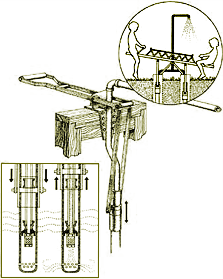 “In the open-air Gaviotas preschool, the children’s see-saw is actually a pump in disguise. As they rise and descend, water gushes from a vertical pipe into an open cement tank. Over the years Gaviotas technicians have installed these in thousands of school yards, using kid power to provide villages with clean water. This simple, inexpensive pump has revolutionised rural life across Colombia for people who used to haul their water in buckets from muddy tropical rivers.” [source]
“In the open-air Gaviotas preschool, the children’s see-saw is actually a pump in disguise. As they rise and descend, water gushes from a vertical pipe into an open cement tank. Over the years Gaviotas technicians have installed these in thousands of school yards, using kid power to provide villages with clean water. This simple, inexpensive pump has revolutionised rural life across Colombia for people who used to haul their water in buckets from muddy tropical rivers.” [source]
“At a windmill-fed cattle trough, surrounded by a sloping cement floor, cowboys have just brought several thirsty calves. As they drink, their dung slides down the slope into a gutter, which sluices it to an enclosed anaerobic fermentation tank, where the cow-pie slurry turns into compost and methane.
The methane flows through pipes to the 16-bed Gaviotas hospital, which a Japanese architectural journal has named one of the 40 most important buildings in the world. It is at once both futuristic and ancient, a maze of angles formed by white walls, glass awnings, skylights, brushed steel columns, and exposed supports trimmed in blue and yellow enamel. The interior is cooled with underground ducts whose hillside intakes face the prevailing breeze. Opposing layers of corrugated roofing create a series of air channels that further bleed away the heat. The combined effect is cost-free, maintenance-free air conditioning. Solar collectors on the roof alternately heat, boil, and distill water. Electricity is from solar photovoltaic cells.
The only hospital within a 12-hour radius, it serves all comers, including both guerrilla and army forces battling in the area. ‘The rule here is never to ask,’ says Bernal. ‘Like the Red Cross, everybody respects us.’
A short, vine-covered walkway connects the Gaviotas hospital to the maloks, a separate wing built by the local Guahivo Indians. Instead of beds, patients and their families lie in hammocks hung from wooden beams under a great thatch roof. Relatives of the sick tend crops of tomatoes, lettuce, and onions in an adjacent hydroponic greenhouse.
If the National University’s pharmacology department and the Guahivo shamans have their way, this greenhouse will one day become the finest medical plant laboratory in the tropics. But money is a critical factor, and Colombia’s expanding, government-owned oil and gas industry has dampened Gaviotas’ solar collector sales by blocking tax benefits for investing in alternative energy. At 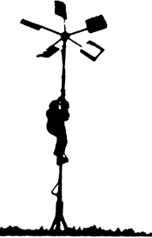 the same time revenue from windmills and pumps dropped as Colombian agriculture was battered by an unexpected onslaught of cheap imported foods, the fallout of new free trade policies.
the same time revenue from windmills and pumps dropped as Colombian agriculture was battered by an unexpected onslaught of cheap imported foods, the fallout of new free trade policies.
So Gaviotas has decided to scale down its manufacturing. But no one is getting laid off. ‘Gaviotas isn’t a company,’ Lugari says, ‘we’re a community. In fact the solution means that both employment and Gaviotas will grow.’
The solution is the nearly 20,000 forested acres. In the past 12 years, Gaviotas has planted 1.6 million Caribbean pines (after finding that no indigenous tree would grow on the prairie). To the surprise of foresters, Gaviotans chose not to cut their standing timber. Instead they are converting their windmill factory to process pine resin. Colombia spends $4 million annually to import such resins for the manufacture of paint, turpentine, and paper. Armed with that fact, Lugari persuaded the Japanese government to provide the seed money, via a grant through the Interamerican Development Bank, to begin tapping and processing resin for the domestic market.” [source]
Since the above was written in 1995, the community no longer purhcases diesel fuel and is now totally energy independent. They generate power with turbine engines fueled by the resin of the Carribean pine trees in their forest. These pines are being slowly crowded out by the regeneration of indigenous rainforest. [source]
Other inventions include:
- a high pressure solar cooker
- methane burners
- hot-water solar panels
- parabolic solar grain driers
- self-cooling rooftops
- cooling wind corridors
- corkscrewing manual well digger
- variety of highly efficient and durable windmills
- specialized bicycle for the Llanos
- pedal powered cassava grinder (10 hours work done in 1 hour)
- rotating drum peanut sheller
- ox-drawn land graders
- one-handed sugarcane press
Gaviotas engineers also designed a solar kettle for the hospital. According to engineer Jaime Dávila, “the principle begins with an old country custom: boil water one day to drink the next, after it cools.” Dávila’s goal was an inexpensive solar-operated system that would give unlimited boiled drinking water, already cooled to room temperature, straight from a tap any time of day, and would work under cloudy skies. The kettle took six years to perfect. It combines solar panels, storage tanks, an efficient heat exchanger, a bit of distillation and a spigot — which you turn to draw off potable water.[source]
See some renderings of their solar collectors, solar oven, and wind-powered musical organ.
The Living Machine
It looks like a botanical garden, but it’s feasting on your sewage — reclaiming waste water for reuse. It’s bioremediation in action. It’s... a Living Machine, “a natural engine to clean water, grow food, regulate climate, even repair damaged habitats.”

“Living Machines accelerate nature’s own water purification process. Unlike chemically based systems, Living Machines incorporate helpful bacteria, plants, snails and fish that thrive by breaking down and digesting organic pollutants.
Wastewater treatment takes place through a series of differently managed environments, a diversity of organisms that eat the waste in the water.
Each Living Machine is custom designed by the engineers of Living Machines, Inc.
Living Machines, Inc. designs each Living Machine to meet each individual client’s needs and requirements. Living Machines typically treat wastewater with six different steps (reactors) or ecologies.”
Though the outputs are not drinkable, there are a variety of agricultural and industrial uses for the processed water.
More than thirty commercial-scale and pilot facilities located throughout the United States and seven other countries, range in size between 300 and 750,000 gallons per day.
The Living Machine system in South Burlington, Vermont cleans 80,000 gallons per day of municipal sewage, an amount typically generated by approximately 1,600 residential users. The waste stream is diverted from the City’s conventional treatment plant. Waste water from the Ethel M Chocolates plant runs through a Living Machine system:
“The treated wastewater is suitable for reuse for on-site landscape irrigation. Sludge is also treated on-site by a composting reed bed, making this a zero discharge facility.”
...
Ocean Arks International is a non-profit organization founded by Living Machine inventor John Todd. Ocean Arks applies the concepts behind the Living Machine to restoring damaged environments.
“Restorer 1” is a floating Living Machine gobbling the contamination of Flax Pond in Harwich, Massachusetts.
“After Flax Pond in Harwich, Massachusetts, a popular swimming and fishing spot and source of irrigation for Cape Cod’s cranberry bogs, was closed in the mid-1980’s due to pollution, Ocean Arks deployed a ‘replacement wetland’: a sun- and wind-powered raft that cycles 100,000 gallons of pond water through nine ecological cells. Three cells harbor microbes to break down the contaminants, and the other six cells, containing typical marsh plants and animals, filter water that then returns to the pond.
Since the Lake Restorer began operation in 1990, beaches have reappeared, oxygen in the water has increased, and the biodiversity of bottom-dwelling invertebrates has blossomed. Although pollutants from the adjacent landfill and septic waste basin continue to leach into the pond from contaminated groundwater, the pond is again safe for swimming and fishing.” [source]
“During the first two years of its operation, the Restorer Living Machine assisted in the digestion of 19,000 cubic meters of anoxic sediments, greatly improving benthic diversity. Additionally, we estimate that the Restorer removes more than 5 kg of ammonia from the pond through denitrification each year in its EFB’s.” [source]
Tyson Foods’s $6 million dollar settlement with the Department of Justice for polluting Maryland’s water included funding for new measures to control the agricultural run-off. In 2001, Ocean Arks International installed an array of 12 “Restorers” to treat the industrial wastewater stream from the Tyson Foods plant in Berlin, Maryland.
Stylish Housing that Fights Pollution
 How do you turn massive liability into a premium asset? Green, green, green.
How do you turn massive liability into a premium asset? Green, green, green.
Take contaminated industrial brownfield, haul away 5 feet of poisonous dirt, add architecture and planning firm, solar heating, wind power, green roofs, gardens that extract pollutants from the soil, huge argon-insulated windows, a view of the coastline and Web accessible remote control.
Then stand back and marvel at the chic elegance of Tango, a designer housing complex in Malmo, Sweden. The complex also recycles its waste water into a rebuilt marsh ecology that mimics the development’s east side, the marshy ecology of the sound. In passing the article mentions that the construction methods and materials were “hewed to ecological building standards that Malmo had set for the district.”
It’s all very geeky and cool, but I look forward to the day when sustainable design is boring and mandated outside of northern Europe, too, not just left to showcase projects that benefit those that can rent at three times the market rate or that make great PR when they pave over industrial contamination.
page 2 1


